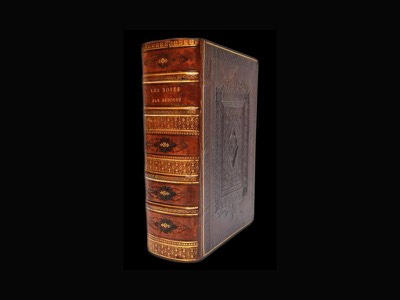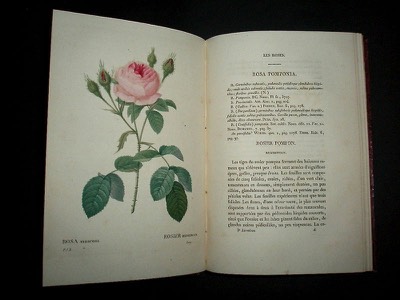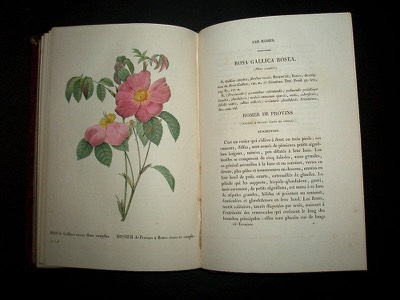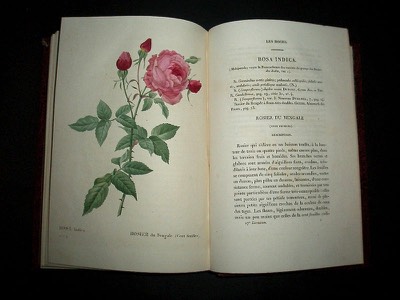Redouté Pierre Joseph
Les Roses, Paris, Panckoucke, 1824
Please scroll down for bibliographic information




Redouté (Pierre Joseph)
Les Roses, peintes par P.J.R. Descrites par Cl. Ant.Thory.
Published in Paris, C.F.L. Panckoucke, 1824. One volume, large 8vo, with 160 coloured stipple-engraved plates, with the original tissue guards; an extraordinary copy in an exquisite full calf contemporary binding, adorned with extensive gold tooled designs. First 8vo edition of Redouté's gargantuan masterpiece, lavishly illustrated with stipple-engravings by Bessa, Bessin, Chapuy, Charlin, Coutant, Langlois, Lemaire, Talbot, Teillard and Victor after the original aquarelles by Redouté, popularly nicknamed the 'Raphael of Flowers'. Designer and painter of the Cabinet of Marie-Antoinette, and later drawing-master to Joséphine de Beauharnais, Redouté was the first to use aquarelle in preference to gouache in his work, and was thus able to imitate the colors of nature with an extraordinary and wholly new degree of precision and delicacy. Les Roses was published under the patronage of Empress Joséphine, whose passion for flowers was legendary. In constant contact with the foremost rose-growers of Europe, her rose-gardens at Malmaison contained examples of virtually every known species. Justifiably proud, in 1800, she commissioned Redouté to paint them. Some eighty of the roses pictured in Les Roses were definitely Malmaison-grown. On the strength of this work, and the similar Les Liliacés, Redouté won the title of 'Flower-painter to the Empress'. The roses painted by Redouté are divided into three categories: wild roses (known in antiquity), roses of the middle-ages, and modern roses, created in the present day from species imported from Asia. The first volume contains a brief bibliography of roses. 'Redouté and Thory knew, described and figured almost all the important roses known in their day. Included were many of the key ancestors of our present-day roses. The plates in Les Roses have artistic value, botanical and documentary value, both for species and cultivars still surviving and for those that have disappeared' (Gisèle de la Roche). Published by subscription, subscribers received four engravings on a monthly basis. AA. Sitwell 128. Dunthorne 233. Sold.
Les Roses, peintes par P.J.R. Descrites par Cl. Ant.Thory.
Published in Paris, C.F.L. Panckoucke, 1824. One volume, large 8vo, with 160 coloured stipple-engraved plates, with the original tissue guards; an extraordinary copy in an exquisite full calf contemporary binding, adorned with extensive gold tooled designs. First 8vo edition of Redouté's gargantuan masterpiece, lavishly illustrated with stipple-engravings by Bessa, Bessin, Chapuy, Charlin, Coutant, Langlois, Lemaire, Talbot, Teillard and Victor after the original aquarelles by Redouté, popularly nicknamed the 'Raphael of Flowers'. Designer and painter of the Cabinet of Marie-Antoinette, and later drawing-master to Joséphine de Beauharnais, Redouté was the first to use aquarelle in preference to gouache in his work, and was thus able to imitate the colors of nature with an extraordinary and wholly new degree of precision and delicacy. Les Roses was published under the patronage of Empress Joséphine, whose passion for flowers was legendary. In constant contact with the foremost rose-growers of Europe, her rose-gardens at Malmaison contained examples of virtually every known species. Justifiably proud, in 1800, she commissioned Redouté to paint them. Some eighty of the roses pictured in Les Roses were definitely Malmaison-grown. On the strength of this work, and the similar Les Liliacés, Redouté won the title of 'Flower-painter to the Empress'. The roses painted by Redouté are divided into three categories: wild roses (known in antiquity), roses of the middle-ages, and modern roses, created in the present day from species imported from Asia. The first volume contains a brief bibliography of roses. 'Redouté and Thory knew, described and figured almost all the important roses known in their day. Included were many of the key ancestors of our present-day roses. The plates in Les Roses have artistic value, botanical and documentary value, both for species and cultivars still surviving and for those that have disappeared' (Gisèle de la Roche). Published by subscription, subscribers received four engravings on a monthly basis. AA. Sitwell 128. Dunthorne 233. Sold.

